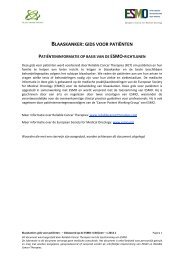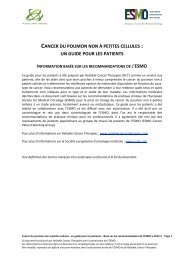Bladder cancer - European Society for Medical Oncology
Bladder cancer - European Society for Medical Oncology
Bladder cancer - European Society for Medical Oncology
Create successful ePaper yourself
Turn your PDF publications into a flip-book with our unique Google optimized e-Paper software.
Recurrence<br />
Cancer or disease (usually auto‐immune) that has come back, usually after a period of time during<br />
which the <strong>cancer</strong> or disease was not present or could not be detected. This may happen in the same<br />
location as the original (primary) tumor or in another location in the body. Also called recurrent<br />
<strong>cancer</strong> or disease.<br />
Reproductive organs/system<br />
The organs involved in producing offspring. In women, this system includes the ovaries, the fallopian<br />
tubes, the uterus, the cervix, and the vagina. In men, it includes the prostate*, the testes, and the<br />
penis.<br />
Renal pelvis<br />
The area at the center of the kidney. Urine collects here and is funneled into the ureter*, the tube<br />
that connects the kidney to the bladder.<br />
Renal tubules<br />
Small canals within the tissue of the kidneys, they contain a filtrate that eventually becomes urine.<br />
They are part of the nephrons, which are the basic functional unit of the kidneys.<br />
Risk factor<br />
Something that increases the chance of developing a disease. Some examples of risk factors <strong>for</strong><br />
<strong>cancer</strong> are age, a family history of certain <strong>cancer</strong>s, use of tobacco products, being exposed to<br />
radiation or certain chemicals, infection with certain viruses or bacteria, and certain genetic changes.<br />
(Bone) Scintigraphy<br />
A procedure that produces pictures (scans) of structures inside the body, including areas where there<br />
are <strong>cancer</strong> cells. Scintigraphy is used to diagnose, stage, and monitor disease. A small amount of a<br />
radioactive chemical (radionuclide) is injected into a vein or swallowed. Different radionuclides travel<br />
through the blood to different organs. A machine with a special camera moves over the person as<br />
they are lying on a table and detects the type of radiation given off by the radionuclides. A computer<br />
<strong>for</strong>ms an image of the areas where the radionuclide builds up. These areas may contain <strong>cancer</strong> cells.<br />
Also called radionuclide scanning.<br />
Seminal vesicles<br />
A pair of tubular glands of about 5 cm in length, that are each curled up inside an ampullary<br />
structure. They are located above the prostate*. Each of them has a duct that connects with the<br />
prostate. They produce most of the fluid contained in the semen.<br />
Sexual dysfunction<br />
Inability to fully enjoy sexual intercourse. It includes a wide variety of problems that affect the sexual<br />
act at any stage: desire, arousal, orgasm, and resolution.<br />
Side effect<br />
A problem that occurs when treatment affects healthy tissues or organs. Some common side effects<br />
of <strong>cancer</strong> treatment are fatigue, pain, nausea, vomiting, decreased blood cell counts, hair loss, and<br />
mouth sores.<br />
<strong>Bladder</strong> <strong>cancer</strong>: a guide <strong>for</strong> patients‐ In<strong>for</strong>mation based on ESMO Clinical Practice Guidelines ‐v.2012.1 Page 26<br />
This document is provided by Reliable Cancer Therapies with the permission of ESMO.<br />
The in<strong>for</strong>mation in this document does not replace a medical consultation. It is <strong>for</strong> personal use only and cannot be modified,<br />
reproduced or disseminated in any way without written permission from ESMO and Reliable Cancer Therapies.
















